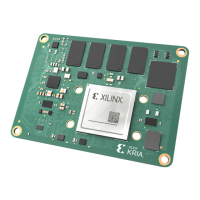Power Management
To power the K26 SOM, it is recommended that you split the power system on your carrier card
is into three power domains:
• Always On Power Domain: The +5V main power and auxiliary power support infrastructure
components such as the power management and telemetry circuits, reset circuits, and
clocking circuits.
• PS Power Domain: The power rails that support the peripherals connected to the PS MIO and
PS-GTR signals.
• PL Power Domain: The power rails that support the peripherals connected to the PL HDIO
and HPIO signals and the V
CCO
rails.
Power Sequencing
The carrier card power management circuit for your applicaon must use the following sequence
to power on the K26 SOM. Your carrier card supplies the +5V SOM power rail (V
CC_SOM
).
1. When the V
CC_SOM
voltage level is within the specied range, the carrier card deasserts the
POWER_OFF_C2M_L signal.
2. The K26 SOM iniates onboard power sequencing.
3. The K26 SOM asserts the VCCOEN_PS_M2C signal, indicang to the carrier card to turn on
the supply rails for the PS peripheral devices.
4. The K26 SOM asserts the VCCOEN_PL_M2C signal, indicang to the carrier card to turn on
the supply rails for the PL peripheral devices as well as all V
CCO
rails for the HPIO and HDIO
banks.
Power Telemetry
RECOMMENDED:
Your carrier card should employ a current sensing device to monitor the input current
on the V
CC_SOM
supply rail that is powering the SOM. Xilinx carrier cards add this current sensing device to
the PS I2C bus to minimize I/O.
Chapter 2: Electrical Design Considerations
UG1091 (v1.0) April 20, 2021 www.xilinx.com
Carrier Card Design for Kria SOM 35

